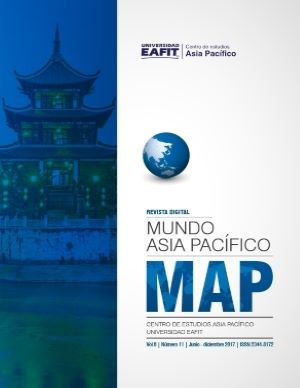HALLYU Y SU PERCEPCIÓN POR LOS JÓVENES COREANOS EN EL CONTEXTO DE LA MARCA PAÍS COREANA
Main Article Content
Keywords
Resumen
Esta investigación tiene como objetivo indagar en las percepciones de los jóvenes coreanos sobre la representatividad del fenómeno cultural llamado Hallyu (o la “Ola coreana”) en el contexto de la Marca País de la República de Corea. El trabajo se fundamenta en encuestas aplicadas a estudiantes universitarios de tres diferentes instituciones en la República de Corea, en el análisis de la información extraída y en trabajo de campo. Esta investigación aporta, desde los datos recopilados de fuentes primarias, una reflexión que no se ha elaborado previamente, ni en la sociedad coreana, ni en otros países, sobre las estrategias de la marca país de la República de Corea, encabezadas desde el Estado, pero no sustentadas por la sociedad del país asiático. El estudio permitió llegar a una conclusión que cuestiona el discurso que se maneja desde las estructuras de poder de la República de Corea.
Descargas
Referencias
Anholt, S. (2003). Brand new justice: the upside of global branding. Oxford: Butterworth-Heinemann.
Anholt, S. (2007). Competitive identity: the new brand management for nations, cities and regions. Nueva York: Palgrave Macmillan.
Anholt, S. (2012). Mito y realidad: la imagen internacional de México. Revista Mexicana de Política Exterior, (96), 109-129.
Aronczyk, M. (2008). Living the brand: nationality, globality and the identity strategies of nation branding consultants. International Journal of Communication, (2), 41-65.
Cheng, L. (2008). The Korea brand: the cultural dimension of South Korea ́s branding project in 2008. SAIS U.S.-Korea Yearbook 2008, Johns Hopkins University, 73-85.
Dinnie, K. (2009). Repositioning the Korea brand to a global audience: challenges, pitfalls, and current strategy. Korea Economic Institute Academic Paper Series, 4(9), 1-7.
Fan, Y. (2006). Branding the nation: what is being branded?. Journal of Vacation Marketing. 12(1), 5-14.
Henrikson, A.K. (2005). Niche diplomacy in the world public arena: the global‘corners’ of Canada and Norway. En Melissen, J. (Ed.), The new public diplomacy: soft power in international relations (pp. 67-87). Nueva York: Palgrave Macmillan.
Howard, K. (2013). The foundation of hallyu – k-pop’s coming of age. First World Congress for Hallyu Studies. Recuperado de http://eprints.soas.ac.uk/15929/
Huang, S. (2011). Nation-branding and transnational consumption: Japan-mania and the Korean wave in Taiwan. Media, Culture & Society, 33(1), 3-18.
Kalshoven, Y.E. (2014). Hallyu power: a focus on soft power in Lee Myung Bak ́s cultural policy. (Tesis de maestría). Leiden University, Leiden, Países Bajos.
Kaneva, N. (2011). Nation branding: toward an agenda for critical research. International Journal of Communication, (5), 117-141.
Kim, S. (2013). Directions and tasks for Park Geun-Hye ́s economic policies. SERI Quarterly, 6(3), 22-29.
Kim y Yong Jin (2016). Cultural policy in the Korean Wave: an analysis of cultural diplomacy embedded in presidential speeches. International Journal of Communication, 10, 5514-5534.
Kofice (2016). 2015 Hallyu-ui kyeonjejeok hyokwa-e kwanhan yeongu (Invesigación sobre el impacto económico del Hallyu en el año 2015). Kofice, Seúl.
Lee, D.H. (2010). Nation branding Korea. SERI Quarterly, 3(2), 103-109.
Lee, D.H. (2012, mayo). Korea nation brand: 2011 survey results. SERI Quarterly, Recuperado de www.seriworld.org/01/wldIssueV.html?mn=B&mncd=0203&p_page=3&key=20120522000001
Lee, D.H. (2012). Nation brands, 2011 survey results. SERI Quarterly, 5(2), 97-102.
Lee, D.H. (2013). Korea nation brand in 2012. SERI Quarterly, 6(2), 100-105.
Jung-yup, L. (2013). Managing the transnational, governing the national: cultural policy and the politics of the “culture archetype project” in South Korea. En N. Otmazgin y E. Ben-Ari (Ed.), Popular culture and the state in East and Southeast Asia (pp. 123-143). London-Nueva York: Routledge.
Lee, K. (2015). Dynamic Korea: amplifying sonic registers in a nation branding campaign. Journal of Korean Studies, 20(1), 113-147.
López Rocha, N. (2012). Hallyu y su impacto en la sociedad mexicana. Estudios Hispánicos, 64, 579-598.
Lopez Rocha, N. (2013). Hallyu in Mexico and the Role of Korean Pop Idols’ Fan Clubs. The Journal of Foreign Studies, 24, 615-637.
Lopez Rocha y Ryzhkov (2014). Hallyu, the current issues of its development and dissemination process in Mexico. Journal of Korean Culture, 26, 119-148.
Melissen, J. (2005). The new public diplomacy: between theory and practice. En J. Melissen. (Ed.), The new public diplomacy: soft power in international relations (pp. 3-27). Nueva York: Palgrave Macmillan
Olins, W. (2005). Making a national brand. En J. Melissen. (Ed.), The new public diplomacy: soft power in international relations (pp.169-179). Nueva York: Palgrave Macmillan.
Park, C. M. (2010). South Korean nation branding: U.S. newspaper media content analysis of South Korea’s image and reputation (tesis de maestría). American University, Estados Unidos de América.
Ryzhkov et al. (2015). Positioning the image of Mexico in the media of English-speaking nations of the Pacific rim: with focus on the USA, Canada and New Zealand. Portes, Revista Mexicana de Estudios sobre la Cuenca del Pacífico, 9(18), 51-76.
Ryzhkov, A. (2016). Construyendo la imagen de México en la República de Corea: posicionamiento en los medios de comunicación escritos, la estrategia marca país e imagen país. Portes, Revista Mexicana de Estudios sobre la Cuenca del Pacífico, 9(19)
Ryzhkov, A. (2016). Imagen de Corea en México: percepción del País de la Calma Matutina en el espacio de los medios impresos mexicanos. En O. Contreras y H. Torres (Ed.), La agenda emergente de las ciencias sociales. Conocimiento, crítica e intervención. Memorias del 5 Congreso Nacional de Ciencias Sociales. (pp. 348-373). Guadalajara: Universidad de Guadalajara/COMECSO.
Seo, Jung, Joo y Lee (2013). Six strategies for sustainable growth of new Korean Wave. Korea Economic Trends, 18(24), 9-14.
Tovar y de Teresa (2012). México y la proyección de una imagen en el exterior por medio de la cultura. Revista Mexicana de Política Exterior, 96, 187-206.

